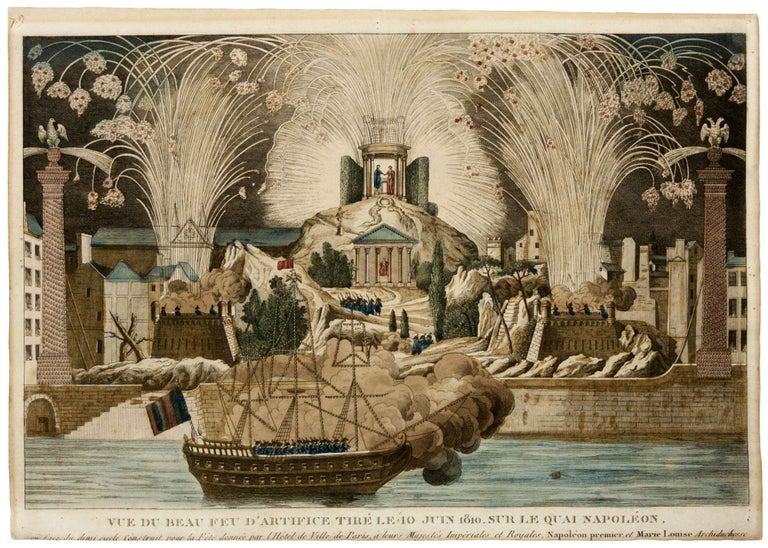
Vue du beau feu d’artifice tire le 10 Juin 1810, sur le Quai Napoleon, en face du demi cycle construit pour la fête donnée par l'Hôtel de Ville de Paris, à leurs Majestés Impériales et Royales, Napoléon premier, et Marie Louise Archiduchesse….
Folio [43.7 x 30.9 cm], (1) Single-sheet etching; narrow margins cropping final line of text at lower edge (“… d’Autriche, son Auguste Epouse, à l’Occasion de leur Mariage célébré le 2 Avril precedent.”), in spectacular early hand color. Rare hand-colored print depicting an elaborate celebration in Paris in honor of Napoleon’s marriage to Marie-Louise of Austria in the spring of 1810 (following his divorce from Josephine in January of that year). An extended period of revelry took place in Paris upon the arrival of the newlyweds from Vienna. The massive spectacle depicted in this separately issued broadside took place on 10 June on the banks of the Seine, in the vicinity of the Hôtel de Ville. Imbert Saint-Amand recalled that, “The month of June was entirely filled with fêtes, each more lavish than the last. During the Empire, one did not do things half way: Be it a battle or a party, everything was colossal” (p. 271). The municipally funded celebrations during the day of the 10th included public theatrical performances on the Champs-Élysées and folk dances throughout the city. The elaborately choreographed nighttime revelry at the Hôtel de Ville began in the evening with a spectacle based on the marriage of Mars and Flora performed by some 500 actors and a full orchestra. Napoleon’s cortège arrived at nine-thirty, and soon thereafter, in front of a crowd of several thousand, there commenced the spectacle pictured here, “a feu d’artifice on the Left Bank, which was set off at the signal of Napoleon and Marie-Louise. The pyrotechnic display was divided into three parts: a military scene, a depiction of the Temple of Peace, and a Temple to the Goddess Hymen. The first scene simulated an attack on two forts by riflemen who shot off fusillades to the sound of trumpets and the din of tambourines. Soldiers atop the forts hurled down bombs, which, when they fell into the river, metamorphosed onto luminous bouquets reflecting across the water. The two forts burst into flames, and then a ship – a symbol of the city of Paris – sailed in and anchored between two illuminated columns. The scene changed again, and then one could see first the Temple of Peace and then the Temple of Hymen” (pp. 272-73). The present broadside was, no doubt, quickly published to serve as an ephemeral souvenir of this extraordinary event. * E. E. Guffey, Drawing an Elusive Line: The Art of Pierre-Paul Prud’hon, pp. 146-150; A. L. Imbert de Saint-Amand, Les beaux jours de l’impératrice Marie-Louise; Napoléon: Le Sacre, exh. cat. (2004), pp. 82-89.
Price: $0.00
